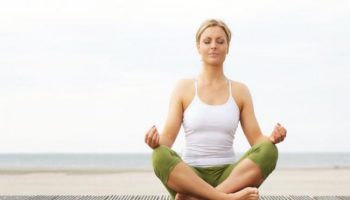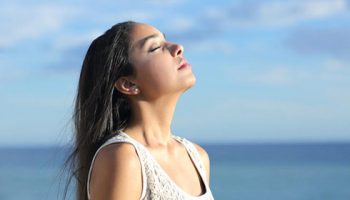State of relaxation achieved as a result of regular yoga practice seems to be involved with energy metabolism pathways, specifically mitochondrial function, in the test subjects.

A study from investigators at the Benson-Henry Institute for Mind/Body Medicine at Massachusetts General Hospital (MGH) and Beth Israel Deaconess Medical Center (BIDMC) finds that elicitation of the relaxation response — a physiologic state of deep rest induced by practices such as meditation, yoga, deep breathing and prayer — produces immediate changes in the expression of genes involved in immune function, energy metabolism and insulin secretion.
Sweating isn’t a sign that you’re losing weight or increasing your metabolic rate. Sweat is a signal that your body is working harder to regulate its internal temperature. |
The Yogasanas listed below will help rev your metabolism so you can reach your weight-loss goals faster!
Parivrtta Utkatasana (Revolved Chair Pose)
- Start from utkatasana (chair pose).
- Align your feet to parallel with your big toes touching and your heels slightly apart, bend deep into your knees, and lift your arms up above your head.
- Take your hands in front of your chest in anjali (prayer) mudra by pressing palms and fingers together, stretching bend fingers.
- Without moving your hips or knees, twist from your shoulders to the right.
- Place your left elbow on your right knee and spin your chest out to the right.
- Press both hands in to each other for more stability.
- Look down, if one of your knees is ahead of the other, pull that corresponding leg back into your hip socket. Otherwise, your knees should be just above your ankles.
- Take a deep inhale, look beyond the tips of your fingers, or look up.
- Exhale to draw your shoulder blades together and further down your back.
- Hold and breathe.
- Option to lift your arms to a T position with your left fingertips pressed into the ground and your right arm directly above your shoulder.
- To exit, exhale out of the twist and inhale out of chair. Repeat on the other side.
Dhanurasana (Bow Pose)
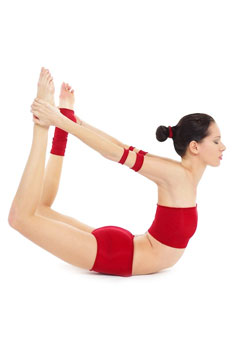 Take prone lying position, legs together, hands straight by the side of the thighs, chin resting on the ground.
Take prone lying position, legs together, hands straight by the side of the thighs, chin resting on the ground.- Fold the legs at the knees and bring them on the thighs. Knees must remain together.
- Bring your hands backward and hold the toes of respective legs from the thumb and forefinger of the respective hands.
- Raise your legs a little up and simultaneously raise your head and chest.
- Holding the toes, pull the legs towards ears and bring the toes near the ear. Gaze in front.
- While returning to this original position, loosen your hands, take legs backward, let the thighs touch the ground, leave the toes and ultimately bring the legs and hand to the first position.
Remember: - Do not try to bring the toes near ears forcefully if it is difficult.
- Gradually increase the practice.
Salabhasana (Locust Pose)
- Lie on your front. Rest your chin on the ground, then move it forward as much as you can, so that your throat lies almost flat. Put your arms by your sides, then push your hands under your body, and make them into fists or clasp them together. Bring your elbows as close together as possible.
- Inhale as you lift one leg. Hold this position for at least 10 seconds, then exhale while lowering your leg and repeat the pose with your other leg. Practice it 3 times on each side. Chin position: The further forward you push your chin, the more your spine can stretch and the more you will gain from this asana.
- Lie with your chin out, then take 3 deep breaths. On the third, lift both legs off the ground. They may not come up far at first, but with practice you may be able to lift them much higher. Hold for as long as you can, then lower your feet. Repeat twice and then relax.
- Up and Up: With practice, you will be able to raise your legs higher. Eventually, you may even be able to lift your body vertically.
Setu Bandha Sarvangasana (Bridge Pose)
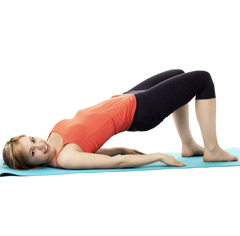 Come to lie on your back with the knees bent and the soles of your feet flat on the floor.
Come to lie on your back with the knees bent and the soles of your feet flat on the floor.- You should be able to barely touch the backs of your heels with your fingertips when the arms are lying on the floor.
- The feet should be parallel and stay that way through the duration of the pose.
- Press down into the soles of the feet as you lift the hips off the floor.
- This should be a comfortable resting position. You may wish to stay here several minutes.
- To come out, press down into your feet and gently lower your back to the floor.
Halasana (Plough Pose)
- Lie down with your back on a Mat.
- Your shoulders should lie on the edge and your head rests on the mat. Your legs are drawn in and still stand on the mat.
- Lift your hips off the floor and bring your legs up, over and beyond your head.
- At this point, lift your back and move your legs further beyond your head.
- Straighten your spine and keep your back straight. Move your hands toward your back.
- Place your arms against your upper back and try to place your hands as near as possible to the shoulder blades. Try to place your elbows at shoulder-width. If you cannot do this, put them at a somewhat wider distance from each other.
Halasana helps in balancing the metabolic system by enabling a good circulation of adrenal, thyroid and pituitary glands. |
Sarvangasana (Shoulder-stand)
- Lie down flat on the floor, on your back, palms by your side facing down.
- Exhale and lift your legs up 30, then 60, then 90 and then around 130 degrees so they are extended behind your head.
- Stay in this position, breathing normally, for a few seconds.
- Now, gradually, exhale again, and straighten your legs up to 90 degrees, lifting your buttocks as well. Support the back of your trunk with your palms, keeping elbows on the floor.
- Gradually, walk your hands towards your shoulder blades, as you lift your body higher.
- Your elbows may tend to move outwards. Bring them in, so they are straight in line with your shoulders.
- You will notice that your hips tend to jut out backwards, while your feet tend to come forward over the head. This is not the right way to do it. Work at it so your body is in a straight line. Your hips, feet and shoulders should be aligned, so push your feet back and bring your hips and tailbone forward. Remember, this exercise is not as much about effort as it is about balance.
- Lift your body as high up as possible. Sarvangasana is a shoulder stand, so your body should be resting on your shoulders and not on your back.
- Hold this position for as long as possible.
- Remember to exhale while lifting your body up, but once your body is up, you can breathe normally.
- There is no need to hold your breath.
- Time yourself, so you can see how long you can remain in this position. The next time, try and balance your body for a little longer.
Matsyasana (Fish Pose)
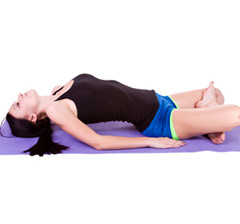 Lie down on your back with your legs straight and your feet together. Place your hands, palms down, underneath your thighs.
Lie down on your back with your legs straight and your feet together. Place your hands, palms down, underneath your thighs.- Pressing down on your elbows, inhale and arch your back. Drop your head back so that the top of your head is on the floor, but your weight should rest on your elbows. Exhale.
- Breathe deeply while in the position, keeping your legs and lower torso relaxed.
- To come out of the pose, lift your head and place it gently back down, then release the arms.
Garudasana (Eagle pose)
- Stand in Tadasana. Bend your knees slightly, lift your left foot up and, balancing on your right foot, cross your left thigh over the right. Point your left toes toward the floor, press the foot back, and then hook the top of the foot behind the lower right calf. Balance on the right foot. If you are a beginner, instead of hooking the raised foot and calf, press the big toe of the raised-leg foot against the floor to help maintain your balance.
- Stretch your arms straight forward, parallel to the floor, and spread your scapulas wide across the back of your torso. Cross the arms in front of your torso so that the right arm is above the left, then bend your elbows. Snug the right elbow into the crook of the left, and raise the forearms perpendicular to the floor. The backs of your hands should be facing each other.
- Press the right hand to the right and the left hand to the left, so that the palms are now facing each other. The thumb of the right hand should pass in front of the little finger of the left.
- Now press the palms together (as much as is possible for you), lift your elbows up, and stretch the fingers toward the ceiling.
- Stay for 15 to 30 seconds, then unwind the legs and arms and stand in Tadasana again. Repeat for the same length of time with the arms and legs reversed.
By regular practice of these yoga-asanas you can keep the metabolic syndrome (a combination of abdominal obesity, high cholesterol, high blood pressure, high triglycerides, or insulin resistance) at bay.
Related Links
- Exercise for Relaxation
- Improving your Metabolism
- Counting Some Health Benefits of Meditation
- Breathing
Disclaimer
The Content is not intended to be a substitute for professional medical advice, diagnosis, or treatment. Always seek the advice of your physician or other qualified health provider with any questions you may have regarding a medical condition.

